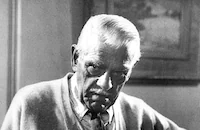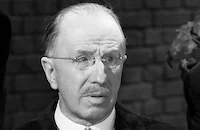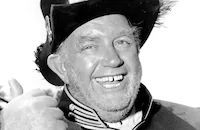The Criminal Code

Brief Synopsis
Cast & Crew
Howard Hawks
Walter Huston
Phillips Holmes
Constance Cummings
Boris Karloff
De Witt Jennings
Film Details
Technical Specs

Synopsis
Young Robert Graham, under the influence of alcohol, accidentally kills the son of Thaddeus Parker, who is running for governor, when the man insults Robert's date. Though sympathetic to the boy, district attorney Mark Brady, who wants to run for governor in the upcoming election, decides to go ahead and prosecute Robert. Robert is sent to prison for ten years. After six years of incarceration, Robert's mother dies, and the boy, on the verge of a nervous breakdown, is given a special assignment by Brady, who after losing the election was appointed as the prison's warden. Appalled at what prison life has done to the young man, Brady makes Robert his chauffeur. Robert and Brady's daughter Mary fall in love. Robert is about to be pardoned when Runch, a stool pigeon, is murdered by Robert's cellmate Galloway, and Brady puts Robert in solitary confinement for refusing to inform on his fellow prisoner. After enduring torture in solitary by the brutal head guard Gleason, Robert is slipped a knife with which to kill Gleason, or himself. That evening, as Robert is on the verge of going through with his plan to kill Gleason, Galloway escapes from his cell and kills Gleason himself, in retaliation for the guard's returning him to prison for a minor parole infraction. Then Galloway confesses to the murder of Runch and is subsequently gunned down by guards who have noticed his attempted escape. Robert is reunited with Mary and they receive Brady's blessings.

Director

Howard Hawks
Cast

Walter Huston

Phillips Holmes

Constance Cummings

Boris Karloff

De Witt Jennings
Mary Doran

Ethel Wales
Clark Marshall

Arthur Hoyt
John St. Polis
Paul Porcasi
Otto Hoffman
John Sheehan
Hugh Walker
Jack Vance
James Guilfoyle

Lee Phelps
Nicholas Soussanin

Andy Devine
Crew

Photo Collections
Videos
Movie Clip


Film Details
Technical Specs

Award Nominations
Best Writing, Screenplay
Articles
The Criminal Code -
Harry Cohn bought the play for Columbia, a small studio that competed with the major Hollywood players with its relatively meager resources. Columbia didn't have a stable of bankable stars under contract or the money for a big slate of expensive pictures but Cohn had big ambitions and he produced a couple of major pictures every year, usually with talent hired from other studios on a per-picture basis. He signed up-and-coming Howard Hawks for a picture and he offered him the project. "It had a great first two acts, then a bad third act," explained Hawks to Peter Bogdanovich, and he brought in screenwriter Seton I. Miller (who had scripted the 1928 A Girl in Every Port and Hawks' 1930 sound debut The Dawn Patrol) to rework the drafts penned by the original playwright, Martin Flavin. Hawks didn't like sentiment in his films and had Miller play against the overtly sentimental scenes with brusque dialogue, a kind of tough-guy shorthand that acknowledges the emotion without making a show of it. And Hawks experimented with overlapping dialogue to give an early scene in a police station an immediacy and realism, a technique that became a signature in his films. To crack the third act, however, Hawks turned not to Miller but to experts on the real criminal code. Hawks had hired ex-convicts to play extras to give the film authenticity and he asked them how they thought it should end. Their suggestions were incorporated into the rewrite.
The story revolves around two central characters: a tough district attorney who is made warden of a high-security prison filled with men he put away and a young man he convicted on a murder charge for a self-defense killing. For the part of the warden, Hawks cast Walter Huston, who he called "the greatest actor I ever worked with." According to Hawks, the warden in the picture was based on a real California attorney who was convicted of corruption and sent to prison. Since the facility was full of men he had put away, he was put under protection in the prison hospital but became fed up with his isolation and walked out into the yard to face down the inmates. "The scene we did in the picture is just what had happened, except that Huston was the warden, rather than a prisoner," described Hawks. "He walked right among them, daring them, and no one made a move."
Apart from Huston, the most memorable character in the film was a prisoner named Galway, played by a journeyman actor who had been working in films and on stage for years but had yet to make an impression: Boris Karloff. "Boris had played the part on stage and knew what he was doing, but he had no form," Hawks told Karloff biographer Cynthia Lindsay. "In The Criminal Code I gave Boris stance. I wanted that huge menacing figure, and Boris wasn't really tall, as you know, so... because I wanted him to appear so huge, I ended up shooting a part of the scene through his legs." Most historians agree that this is the role that brought Karloff to the attention of James Whale, who cast him as Frankenstein's Monster in Frankenstein.
When Peter Bogdanovich made Targets (1968) with Boris Karloff, who played an aging horror movie star nearing the end of his career, he included a clip from The Criminal Code featuring Karloff, using it to springboard into a discussion of Howard Hawks movies. Karloff had told Bogdanovich that it was his first really important part, a line that he put in the dialogue, and when Bogdanovich (who cast himself in a small role) says of Hawks, "He really knows how to tell a story," Karloff sincerely and appreciatively ad-libbed, "Indeed he does." Bogdanovich kept the line in the film.
By Sean Axmaker
Sources:
Who the Devil Made It?, Peter Bogdanovich. Knopf, 1997.
Who the Hell's In It?, Peter Bogdanovich. Knopf, 2004.
Howard Hawks, American Artist, ed. Jim Hillier and Peter Wollen. BFI, 1996.
Dear Boris: The Life of William Henry Pratt, a.k.a. Boris Karloff, Cynthia Lindsay. Hal Leonard Corporation, 1995.
Hawks on Hawks, Joseph McBride. University of California Press, 1982.
Howard Hawks, Todd McCarthy. Alfred A. Knopf, 1997.

The Criminal Code -
Quotes
Trivia
Boris Karloff had previously played the role of Galloway in the stage production.
Notes
Photographer James Wong Howe's surname is misspelled "How" in the onscreen credits. Seton Miller and Fred Niblo, Jr. were nominated for an Academy Award for their adaptation of the play on which this film is based. This film was also made in Spanish and French versions (see entry for El código penal). Modern sources list the following additional credits for the English language version: L. William O'Connell, Photography; David Selman, Assistant Director; Edward Jewell, Art Director; Edward Shulter, Tech dir. In an interview that appears in a modern source, Howard Hawks is quoted as having said that the play's last act "was absolutely no good." Hawks said that he liked the rest of the play, however, and decided to improve it by meeting with twenty convicts and asking them to decide how it ends. According to Hawks, "they told me the whole ending, the whole last act."
Actress Constance Cummings (1910-2005) made her motion picture debut in The Criminal Code. The film was remade by Columbia in 1938 as Penitentiary (see below). In 1950, the film was again remade as Convicted, directed by Henry Levin, and starring Glenn Ford and Broderick Crawford. A portion of The Criminal Code was used in Peter Bogdanovich's 1967 film Targets.














